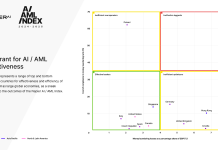Adapting to emerging threats requires a comprehensive understanding of identification, translation, and assessment. Developing the Business Wide-Risk Assessment (BWRA) into a core part of our operations can greatly aid this process.
Acuminor, a RegTech platform, recently explained the importance of effective risk assessment and control.
Financial crime prevention is a significant challenge, particularly in the FinTech sector. Recently, the Financial Conduct Authority (FCA) highlighted this challenge in a speech delivered by Sarah Pritchard, executive director of markets and international, at the Future of Non-Financial Risk and Control conference (XLOD Global, New York). In her remarks, Pritchard emphasised the importance of immediate regulatory action in response to evolving threats.
Unlike regulators, law enforcement and financial institutions operate on the front lines of financial crime. They maintain effective financial crime control frameworks to build trust and ensure positive relationships with regulators. Supported by Technology Partners, these institutions are ideally positioned to combat financial crime, making significant differences in detection, prevention, and accountability.
In her address, Pritchard stressed the importance of calibrating financial crime controls to respond to current threats and risks. She recommended that financial institutions regularly assess their strategies, ask pertinent exploratory questions, and ensure agility in updating controls in response to changing threats.
The emphasis on financial institutions’ role in combating crime is critical for two reasons. Firstly, these institutions have been navigating an unprecedented period of regulatory changes, including Money Laundering Regulations or Sanctions related to global geopolitical events, such as the Russian invasion of Ukraine. This has led to a focus on compliance that can often become a mere box-ticking exercise.
Secondly, the UK government’s recent Economic Crime Plan (2023-2026) indicates a shift towards an outcomes-focused approach. This strategy aims to channel resources towards agreed priorities, thereby effectively reducing financial crime. To accomplish this, it’s necessary to analyse and understand the threats through deep investigation.
While regulators and law enforcement bodies provide intelligence, a wealth of high-quality intelligence also comes from public and private bodies. Organisations need to effectively translate this intelligence into risk indicators, prioritising threats and addressing the gaps that could lead to catastrophic consequences.
Each organisation faces unique threats, risks, and associated risk levels due to variations in their size, operational locations, offerings, and customer bases. Therefore, the implementation of controls should be tailored to the unique threat and risk landscape. A plug-and-play approach, without adequate understanding of the inherent threat and risk landscape, can lead to poor outcomes, including harm to customers.
The BWRA provides an opportunity for firms to identify and assess the impact and probability of relevant threats. By translating this into risk indicators, firms can prioritise control design and operation. This process helps organisations establish better outcomes by understanding cross-framework control effectiveness.
Financial crime intelligence company Acuminor helps in this process. It gathers, analyses, and translates the complex intelligence landscape into threats and risks. This enables an intelligence-led BWRA, helping to diagnose specific threats and risks quickly. Acuminor’s Risk Assessment Professional platform further aids in assessing the effectiveness of existing control frameworks, providing evidence-based improvements where necessary.
Read the story here.
Keep up with all the latest FinTech news here
Copyright © 2023 FinTech Global
Copyright © 2018 RegTech Analyst






